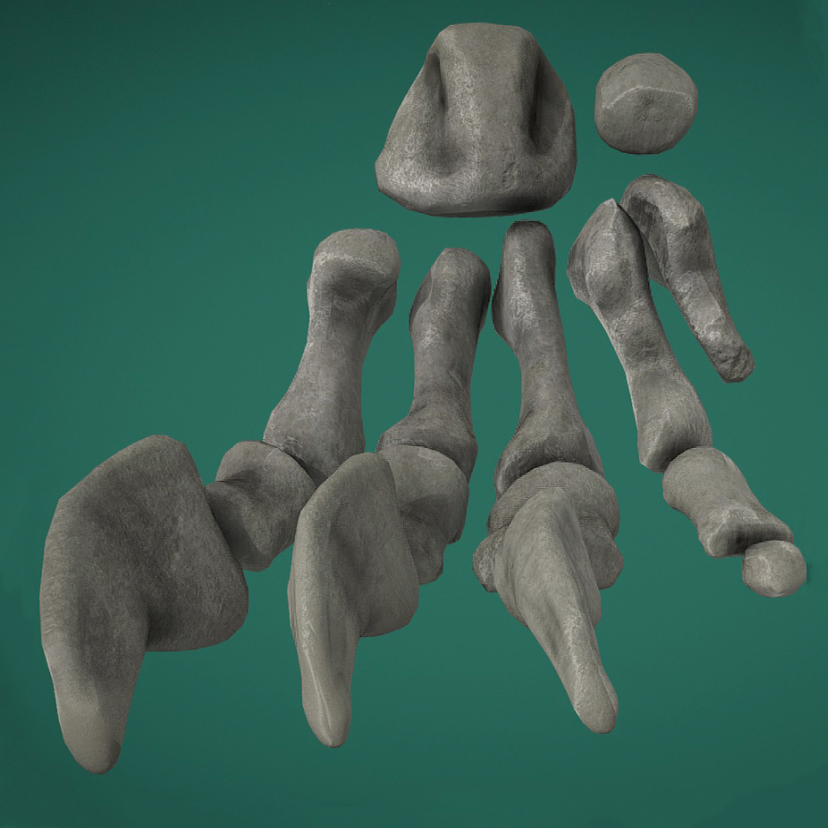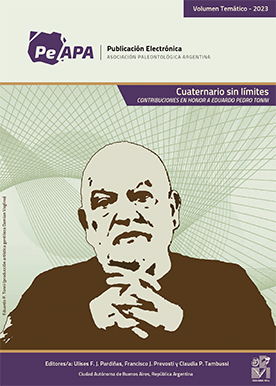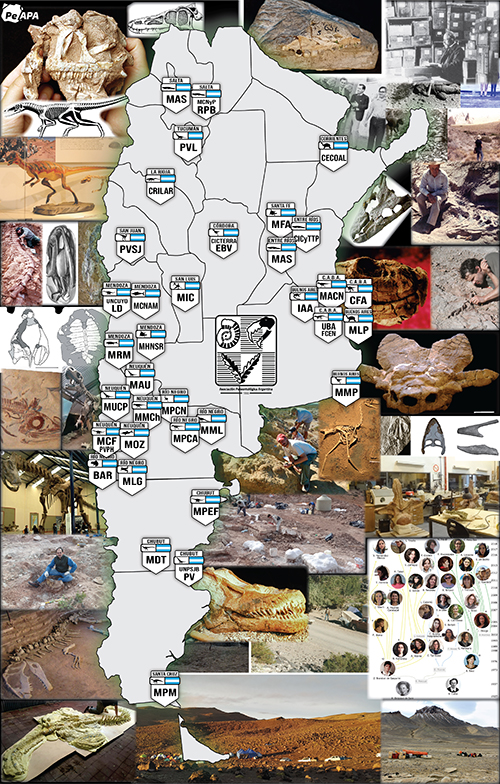GUÍA PARA LA RECONSTRUCCIÓN DE LOS AUTOPODIOS DE LOS TETRAPODA MEDIANTE TECNOLOGÍA 3D: EL CASO DE NEUQUENSAURUS AUSTRALIS (SAUROPODA: TITANOSAURIA)
DOI:
https://doi.org/10.5710/PEAPA.04.10.2023.483Palabras clave:
Escáner, Modelo 3D, Retrodeformación, Muse de La Plata, Impresi´ón 3D, DinosauriaResumen
Esta contribución presenta una metodología detallada para la reconstrucción de los autopodios anteriores y posteriores (elementos de la mano y el pie) del dinosaurio saurópodo Neuquensaurus australis. El estudio utiliza varias técnicas, como el escaneado digital tridimensional (3D), la reconstrucción, la retrodeformación, el escalado, la texturización, la renderización, la impresión 3D y el montaje, para crear representaciones precisas de los elementos fósiles. Se emplearon dos dispositivos de escaneado diferentes para capturar modelos 3D de alta resolución de los elementos fósiles. Los datos escaneados se procesaron para alinear y fusionar los puntos, con lo que se obtuvieron modelos 3D detallados. Taxones relacionados, como Argyrosaurus superbus y técnicas de modelado 3D fueron usados para la reconstrucción de los elementos faltantes. Se realizaron cálculos de escala basados en análisis comparativos con otros titanosaurios para estimar el tamaño de los elementos faltantes. Se aplicó la retrodeformación para corregir la distorsión tafonómica y restaurar la forma original de los elementos fósiles. También se emplearon técnicas de texturizado y renderizado para mejorar la calidad visual de los modelos 3D. Los modelos 3D se imprimieron posteriormente en 3D usando filamento ácido poliláctico (PLA) blanco. La creación de réplicas físicas es útil para estudios posteriores, fines educativos y divulgación pública. Destacamos las ventajas de la impresión 3D en paleontología, como la rentabilidad y la accesibilidad, ya que crea réplicas precisas sin poner en peligro los fósiles originales. En conjunto, las metodologías presentadas demuestran el potencial de las tecnologías 3D en la investigación paleontológica. La combinación de escaneado, reconstrucción, retrodeformación, escalado, texturizado, renderizado e impresión 3D proporciona un enfoque integral para reconstruir y visualizar con precisión elementos fósiles. Estas técnicas contribuyen a una mejor comprensión de los vertebrados extintos y su biomecánica.
Referencias
Apesteguía, S. (2004). Bonitasaura salgadoi gen. et sp. nov.: a beaked sauropod from the Late Cretaceous of Patagonia. Naturwissenschaften, 91, 493–497.
Arbour, V. M. & Currie, P. J. (2012). Analyzing taphonomic deformation of ankylosaur skulls using retrodeformation and finite element analysis. PLoS ONE, 7(6), 1–13. https://doi.org/10.1371/journal.pone.0039323
Borsuk-Bialynicka, M. (1977). A new camarasaurid sauropod Opisthocoelicaudia skarzynskii gen. n., sp. n. from the Upper Cretaceous of Mongolia. Palaeontologia Polonica, 37(5), 5–64.
Boyd, A. A. & Motani, R. (2008). Three-dimensional re-evaluation of the deformation removal technique based on ‘‘jigsaw puzzling’’. Palaeontologia Electronica, 11(2), 7A.
Breithaupt, B. H., Matthews, N. A. & Noble, T. A. (2003). An integrated approach to three-dimensional data collection at dinosaur tracksites in the Rocky Mountain West. Ichnos, 11(1–2), 11–26. https://doi.org/10.1080/10420940490442296
Cheng, L., Antonenko, P. D., Ritzhaupt, A. D., Dawson, K., Miller, D., MacFadden, B. J., ... & Ziegler, M. (2020). Exploring the influence of teachers' beliefs and 3D printing integrated STEM instruction on students’ STEM motivation. Computers & Education, 158, 103983.
Cunningham, J. A., Rahman, I. A., Lautenschlager, S., Rayfield, E. J. & Donoghue, PC. J. (2014). A virtual world of paleontology. Trends in Ecology & Evolution, 29(6), 347–357. https://doi.org/10.1016/j.tree.2014.04.004.
Curry Rogers, K. & Forster, C. A. (2001). The last of the dinosaur titans: a new sauropod from Madagascar. Nature, 412(6846), 530–534.
Cuvier, G. (1796). Notice sur le squelette d’une très grande espèce de quadrupède inconnue jusqu’à présent, trouvé au Paraquay, et déposé au cabinet d’histoire naturelle de Madrid. Magasin encyclopédique, ou Journal des Sciences, des Lettres et des Arts, 1, 303–310; 2, 227–228
Díez Díaz, V., Demuth, O., Schwarz, D. & Mallison, H. (2020). The Tail of the Late Jurassic Sauropod Giraffatitan brancai: Digital Reconstruction of Its Epaxial and Hypaxial Musculature, and Implications for Tail Biomechanics. Frontiers in Earth Science, 8(160). 10.3389/feart.2020.00160.
Dunlavey, T. (2008). Image interpretation is important to paleontology? Case studies in data acquisition, fidelity, and retrodeformation using bilaterally symmetric graptolite (Isograptus and Pseudisograptus) and trilobite (Triarthrus beckii and eatonii) fossils. PhD Thesis, State University of New York at Buffalo]. Retrieved from https://www.proquest.com/openview/dc67934b81090978e3f7fe465606b024/1?pq-origsite=gscholar&cbl=18750
Gonzalez Riga, B. J. (2003). A new titanosaur (Dinosauria, Sauropoda) from the Upper Cretaceous of Mendoza province, Argentina. Ameghiniana, 40(2), 155–172.
Grant, C. A., MacFadden, B. J., Antonenko, P. & Perez, V. J. (2016). 3-D Fossils for k–12 education: A case example using the giant extinct shark Carcharocles megalodon. The Paleontological Society Papers, 22, 197–209.
Hatcher, J. B. (1901). Diplodocus (Marsh): Its osteology, taxonomy, and probable habits, with a restoration of the skeleton. Memoirs of the Carnegie Museum, 1, 1–63.
Hutchinson, J. R., Anderson, F. C., Blemker, S. S. & Delp, S. L. (2005). Analysis of hindlimb muscle moment arms in Tyrannosaurus rex using a three-dimensional musculoskeletal computer model: implications for stance, gait, and speed. Paleobiology, 31(4), 676. https://doi.org/10.1666/04044.1
Hutchinson, J. R. & Garcia, M. (2002). Tyrannosaurus was not a fast runner. Nature, 415(1), 1018–1021. https://doi.org/10.5926/jjep1953.34.1_84
Janensch, W. (1950). The Vertebral Column of Brachiosaurus brancai. Palaeontographica, 1(3), 27–93.
Johnson, E. H. & Carter, A. M. (2019). Defossilization: a review of 3D printing in experimental paleontology. Frontiers in Ecology and Evolution, 7, 430.
Klinkhamer, A. J., Wilhite, D. R., White, M. A. & Wroe, S. (2017). Digital dissection and three-dimensional interactive models of limb musculature in the Australian estuarine crocodile (Crocodylus porosus). PLoS ONE, 12(4), 17–22. https://doi.org/10.1371/journal.pone.0175079
Lacovara, K. J., Lamanna, M. C., Ibiricu, L. M., Poole, J. C., Schroeter, E. R., Ullmann, P. V., ... & Novas, F. E. (2014). A gigantic, exceptionally complete titanosaurian sauropod dinosaur from southern Patagonia, Argentina. Scientific Reports, 4(1), 6196.
Lautenschlager, S. (2016). Reconstructing the past: Methods and techniques for the digital restoration of fossils. Royal Society Open Science, 3(10). https://doi.org/10.1098/rsos.160342
Lydekker, R. (1893). The dinosaurs of Patagonia. Anales Del Museo de La Plata, 2, 1–14.
Mallison, H. (2010a). CAD assessment of the posture and range of motion of Kentrosaurus aethiopicus Hennig 1915. Swiss Journal of Geosciences, 103(2), 211–233. https://doi.org/10.1007/s00015-010-0024-2
Mallison, H. (2010b). The digital Plateosaurus I: Body mass, mass distribution and posture assessed using cad and cae on a digitally mounted complete skeleton. Palaeontologia Electronica, 13(2), 1–26.
Mallison, H. & Wings, O. (2014). Photogrammetry in paleontology—a practical guide. Journal of Paleontological Techniques, 12(12), 1–31.
Motani R. (1997) New technique for retrodeforming tectonically deformed fossils, with an example for ichthyosaurian specimens. Lethaia, 30, 221–228.
Otero, A. & Gasparini, Z. (2014). The history of the cast skeleton of Diplodocus carnegii Hatcher, 1901, at the Museo de la Plata, Argentina. Annals of Carnegie Museum, 82(3), 291–304.
Otero, A., Moreno, A. P., Falkingham, P. L., Cassini, G., Ruella, A., Militello, M. & Toledo, N. (2020). Three-dimensional image surface acquisition in vertebrate paleontology: a review of principal techniques. Publicación Electrónica de la Asociación Paleontológica Argentina, 20(1), 1–14. http://dx.doi.org/10.5710/PEAPA.04.04.2020.310
Paul, G. S. & Chase, T. L. (1989). Reconstructing extinct vertebrates. In: E.R.S. Hodges (ed.), The Guild Handbook of Scientific Illustration, 239–256. Van Nostrand Reinhold, New York.
Peterson, J. E. & Krippner, M. L. (2019). Comparisons of fidelity in the digitization and 3D printing of vertebrate fossils. Journal of Paleontological Techniques, 22, 1–9.
Rahman, I. A., Adcock, K. & Garwood, R. J. (2012). Virtual fossils: a new resource for science communication in paleontology. Evolution: Education and Outreach, 5, 635–641.
Reiss, S. & Mallison, H. (2014). Motion range of the manus of Plateosaurus engelhardti von Meyer, 1837. Palaeontologia Electronica, 17(1), 1–19.
Schlager, S., Profico, A., Di Vincenzo, F. & Manzi, G. (2018). Retrodeformation of fossil specimens based on 3D bilateral semi-landmarks: Implementation in the R package “Morpho”. PloS ONE, 13(3), e0194073. https://doi.org/10.1371/journal.pone.0194073
Stevens, K. A. (2013). The Articulation of Sauropod Necks: Methodology and Mythology. PLoS ONE, 8(10), e78572. https://doi.org/10.1371/journal.pone.0078572
Stevens, K. A. & Parrish, J. M. (1999). Neck posture and feeding habits of two Jurassic sauropod dinosaurs. Science, 284, 798–800. doi: 10.1126/science.284.5415.798
Steyer, J. S., Boulay, M. & Lorrain, S. (2010). 3D external restorations of stegocephalian skulls using Zbrush: the renaissance of fossil amphibians. Comptes Rendus Palevol, 9(6–7), 463–470.
Sutton, M. D., Rahman, I. A.& Garwood, R. J. (2014). Techniques for Virtual Palaeontology. John Wiley & Sons.
Vidal, D. & Díez Díaz, V. (2017). Reconstructing hypothetical sauropod tails by means of 3D digitization: Lirainosaurus astibiae as case study. Journal of Iberian Geology, 43(2), 293–305. https://doi.org/10.1007/s41513-017-0022-6
Wedel, M. J. (2003a). The evolution of vertebral pneumaticity in sauropod dinosaurs. Journal of Vertebrate Paleontology, 23, 344–357.
Wedel, M. J. (2003b). Vertebral pneumaticity, air sacs, and the physiology of sauropod dinosaurs. Paleobiology, 29(2), 243–255. https://doi.org/10.1017/S0094837300018091
Xing, L., Ye, Y., Shu, C., Peng, G. & You, H.-L. (2009). Structure, orientation and finite element analysis of the tail club of Mamenchisaurus hochuanensis. Acta Geologica Sinica, 83(6), 1031–1040.
Zollikofer, C. P. E. & de León, M. S. P. (2005). Virtual Reconstruction. A primer in computer-assisted paleontology and biomedicine. Wiley..

Archivos adicionales
Publicado
Número
Sección
Licencia
Derechos de autor 2024 Agustín Roberto Ruella, Agustín Pérez Moreno, Yanina Herrera

Esta obra está bajo una licencia internacional Creative Commons Atribución-SinDerivadas 4.0.

Los/las autores/as conservan los derechos de autor/a y garantizan a la revista el derecho de ser la primera publicación del trabajo licenciado bajo una licencia CC Attribution-NonCommercial 4.0 que permite a otros/as compartir el trabajo con el reconocimiento de la autoría y de la publicación inicial en esta revista.




















